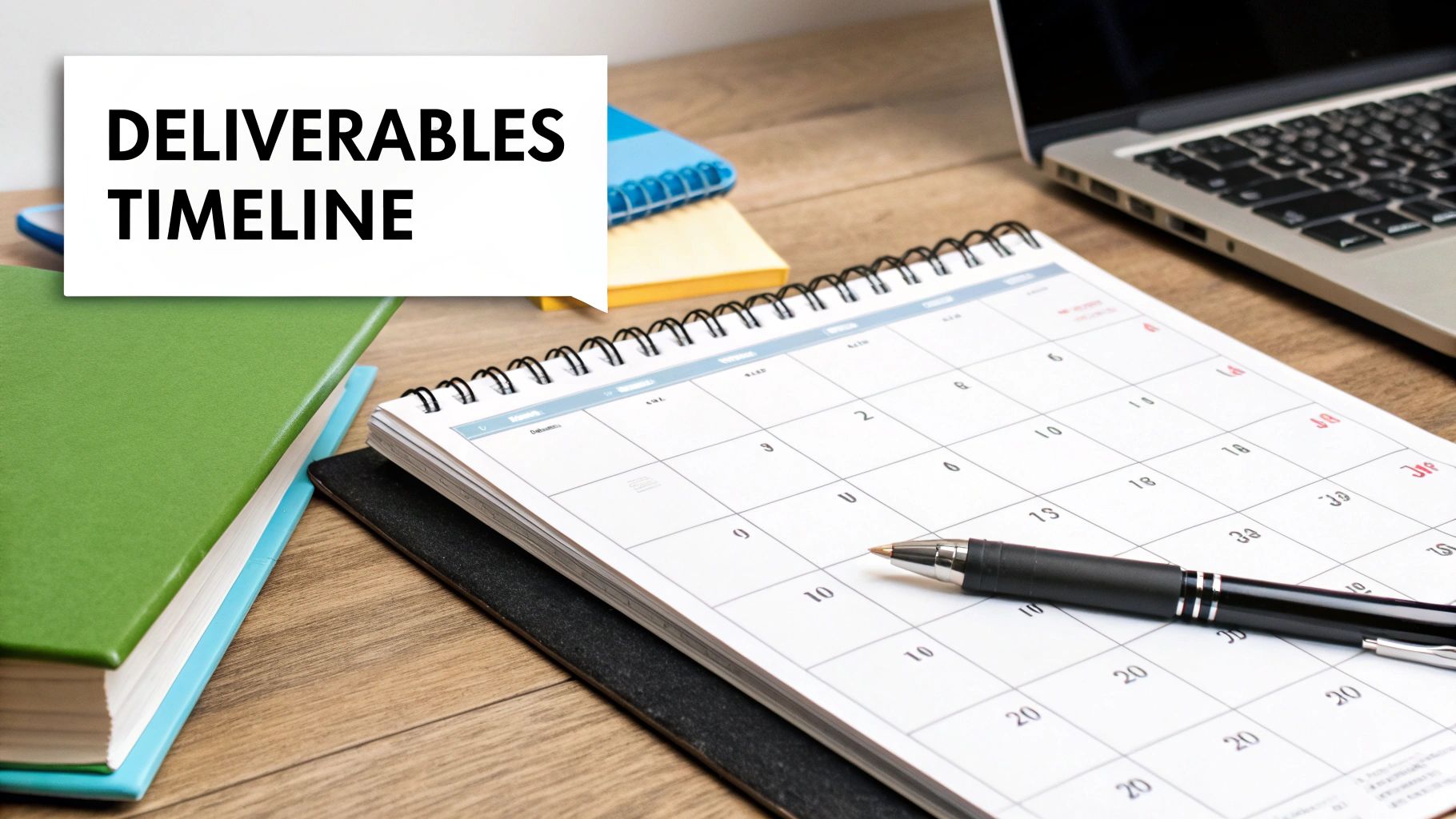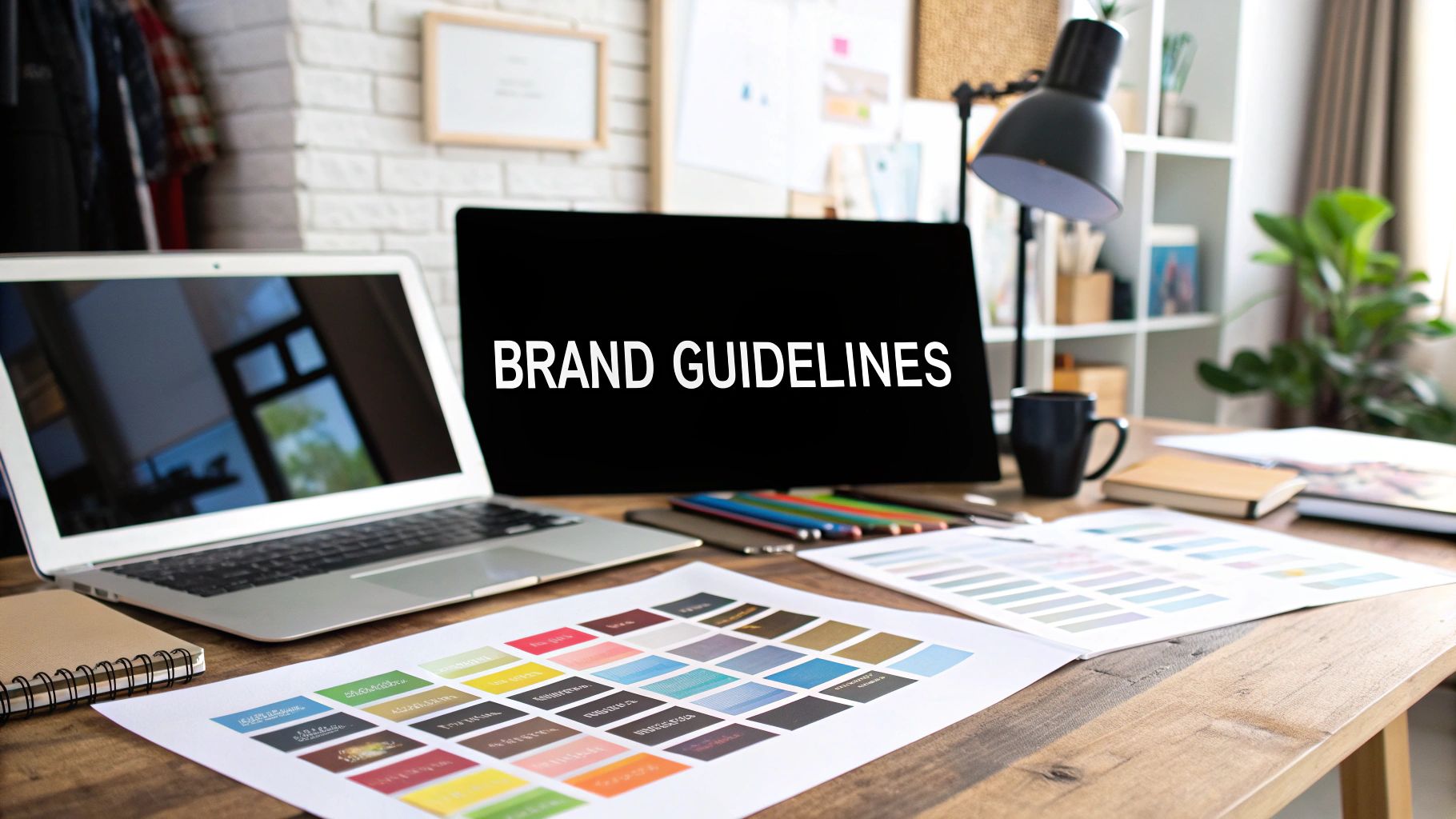Why Creative Brief Templates Transform Project Outcomes

Have you ever witnessed a project derail despite everyone's best efforts? A creative brief template acts as the essential groundwork, preventing this common issue. It ensures all team members are aligned from the beginning, minimizing misunderstandings and maximizing productivity. This initial effort saves valuable time and resources by significantly reducing the need for expensive mid-project changes.
This highlights that creative brief templates are much more than simple checklists; they are the foundation of successful projects. They offer clear guidance while fostering innovative thinking. High-performing teams recognize the importance of a well-defined brief, using it as a roadmap throughout the project's lifecycle. This forward-thinking approach paves the way for a smooth and efficient creative process.
The Evolution of Creative Briefs
The concept of a creative brief is not a new one. It has changed significantly over time. Traditionally, these documents were often extensive and overly detailed, covering every aspect of a project’s background. However, modern creative briefs have become more concise and targeted.
They deliver key information without overwhelming the creative team, allowing for greater flexibility and promoting more innovative approaches to campaigns. To learn more about how creative briefs have developed, check out this helpful resource: Discover more insights about creative briefs.
Benefits of Using a Creative Brief Template
A well-structured template ensures consistency and clarity across all projects. This is especially helpful for larger teams or organizations managing multiple projects simultaneously. Using a template helps maintain a standardized approach, reducing the risk of miscommunication and ensuring all necessary information is included.
-
Prevents Scope Creep: Clearly defined objectives and deliverables in the template help avoid scope creep, keeping the project on track and within budget.
-
Streamlines Communication: The template promotes clear communication between stakeholders, making sure everyone understands the project goals and expectations.
-
Fosters Creativity: By providing a clear framework, the template empowers creatives to focus their energy on generating innovative ideas, rather than deciphering ambiguous instructions.
-
Reduces Revisions: A thoughtfully prepared brief minimizes the need for revisions by ensuring the creative team understands the project requirements from the outset.
Making Your Creative Brief Template a Cornerstone
Establishing your creative brief template as the project's cornerstone requires a change in perspective. It should be seen as a dynamic resource that guides the entire process.
Regularly reviewing and updating the brief throughout the project lifecycle ensures its continued relevance and value as the central reference point for all involved. This collaborative approach reinforces team alignment and ultimately contributes to more successful project outcomes.
The 7 Essential Elements Every Creative Brief Template Needs
A well-crafted creative brief template is essential for any successful creative project. It serves as a roadmap, guiding the team from the initial brainstorming session to the final product. But what makes a creative brief truly effective? Let's explore the seven essential elements that transform a brief from a confusing document into a powerful tool.
1. Project Overview: Setting the Stage
Start with a clear and concise project overview. This section sets the stage by outlining the project's purpose and scope. It also clarifies the desired outcomes. This overview acts as the executive summary, providing a snapshot of the project's core objectives.
2. Target Audience: Knowing Your Consumer
Understanding your target audience is crucial. This section dives into the demographics, psychographics, and behaviors of your ideal consumer. A detailed audience analysis helps the creative team tailor the message for maximum impact.
3. Objectives: Defining Measurable Goals
Clearly define what you want to achieve with the project. This section outlines SMART objectives: Specific, Measurable, Achievable, Relevant, and Time-bound. These objectives provide a clear target for the creative team and benchmarks for evaluating success.
4. Messaging: Crafting the Narrative
Here, the core message of your project takes shape. This section articulates the key takeaways you want your audience to remember. The messaging should be compelling, concise, and aligned with your overall brand voice.
5. Deliverables: Outlining the Output
This section specifies the project's tangible outputs. It includes the formats, sizes, and other technical requirements for the creative assets. This ensures everyone understands what needs to be created and its specific form. Globally, creative brief templates often include around 22 slides covering elements like project overview and target audience. According to Pitch, outlining the campaign, brand, and history is a good starting point for any creative brief template.
To understand the core components of a creative brief template, let's take a look at the following table:
Core Components of a Creative Brief Template
Comparison of essential elements across different types of creative brief templates
| Component | General Marketing Brief | Video Production Brief | Design Project Brief | Digital Campaign Brief |
|---|---|---|---|---|
| Project Overview | Project goals, target market | Video purpose, style, length | Design goals, target audience | Campaign objectives, target platforms |
| Target Audience | Demographics, psychographics | Viewer demographics, viewing habits | User demographics, user needs | Target audience segments, online behavior |
| Objectives | Marketing objectives, KPIs | Video engagement metrics | Design performance metrics | Campaign reach, engagement, conversions |
| Messaging | Key messages, brand voice | Script, storyboard, narrative | Design language, visual style | Campaign messaging, social media strategy |
| Deliverables | Marketing materials, reports | Finished video, raw footage | Design files, mockups, prototypes | Digital assets, social media posts, website updates |
| Timeline | Marketing schedule, deadlines | Production schedule, delivery date | Design milestones, project deadlines | Campaign timeline, launch date |
| Budget | Marketing budget allocation | Video production costs | Design project budget | Campaign budget, media spend |
This table highlights the key components and how they are adapted for different project types. While there are common elements, the specifics vary depending on the nature of the creative endeavor.
6. Timeline: Establishing Deadlines
Every project needs a well-defined timeline. This section outlines key milestones and deadlines. This keeps the project on track and manages expectations. A clear timeline ensures everyone stays accountable.
7. Budget: Managing Resources
The budget section outlines the financial resources allocated to the project. Transparency about budget constraints allows the creative team to make informed decisions. It also helps prioritize resources effectively. A clear budget minimizes potential financial surprises.
By incorporating these seven essential elements into your creative brief template, you empower your team to produce exceptional work. This structured approach fosters a more focused and efficient creative process, ultimately leading to better results that resonate with your target audience.
Transforming Your Creative Brief With Data-Driven Insights

Why do some creative briefs lead to amazing work, while others fall flat? The secret often lies in using data. This section explores how top creative teams are ditching guesswork and embracing data-driven insights for more effective briefs.
Creative briefs are no longer just about gut feelings and inspiration. They're about strategically connecting creative vision with actual consumer behavior and market trends. Imagine building a campaign around a product feature you think consumers want, only to find data reveals a completely different need.
The Power of Data-Informed Decisions
Data helps you uncover these hidden opportunities and avoid expensive mistakes. It allows your team to focus on what truly connects with the target audience. Plus, data helps measure campaign performance accurately, providing valuable feedback for future projects. Incorporating data into creative briefs has become essential for better campaigns. Data-driven briefs align project goals with consumer realities and market trends.
For instance, using data tools like GlobalWebIndex can reveal insights about consumer attitudes and preferences that might clash with a brand’s goals, highlighting both challenges and opportunities. Approximately 70% of marketers report increased efficiency and 60% see improved campaign performance with data-driven strategies. Learn more about this.
Integrating Data Effectively Into Your Creative Brief Template
Adding data doesn’t mean stuffing your creative brief template with endless statistics. The key is choosing relevant data points that directly inform creative direction without hindering the creative process.
-
Market Research: Include important market data about your industry, competitors, and target audience. This sets the foundation for a strategically sound campaign.
-
Consumer Behaviors: Analyze consumer preferences, buying habits, and online activity. This gives invaluable clues about what motivates your target audience.
-
Performance Metrics: Use data from past campaigns to see what succeeded and what needs tweaking. This lets you refine your approach for better outcomes.
Inspiring Creativity With Data-Driven Insights
Data shouldn’t limit creative thinking; it should fuel innovation. Present data visually to inspire creative solutions. This could include:
-
Infographics: Summarize key data points in a visually appealing format.
-
Data Visualizations: Use charts and graphs to show trends and patterns.
-
Consumer Personas: Build representative profiles of your ideal customer using data insights.
By strategically using data in your creative brief template, you empower your team to create work that grabs attention and delivers real results. This approach ensures your creative efforts support business goals and truly resonate with your target audience.
Building Flexible Templates for Different Creative Challenges

A strong creative brief template is essential. But a rigid, one-size-fits-all approach can limit creativity. This section explores how adapting your template for different projects ensures both strategic alignment and brilliant creative output. Think of your template like a tailored suit: the basic structure is consistent, but adjustments ensure the perfect fit.
Adapting Your Creative Brief Template: A Tailored Approach
High-performing creative teams know the value of template flexibility. They adapt their briefs to meet the unique needs of various creative disciplines, maintaining consistency throughout. A brief for branding, for instance, differs significantly from one for a product launch. This demands a thoughtful approach to customization.
Key Modifications for Different Project Types
Adapting your creative brief template goes beyond simply changing the project title. It requires understanding the nuances of each project and adjusting the content accordingly. This involves recognizing which sections to expand, which to condense, and when specialized elements are necessary.
-
Project Complexity: For complex projects, expand sections like "Timeline" and "Budget" for detailed planning. For simpler projects, these sections can be more concise.
-
Specialized Components: A video production brief might need a dedicated "Storyboard" and "Shot List" section, while a design brief might require "Style Guide" and "Brand Guidelines."
-
Touchpoints: For projects with multiple stakeholders, incorporate touchpoints throughout the briefing process to maintain alignment. This could involve additional review stages or feedback sessions.
Real-World Examples: Tailoring Your Template
Let's look at examples of how template variations improve creative results:
-
Branding Initiatives: Prioritize the "Brand Voice" and "Target Audience" sections to ensure creative aligns with the overall brand identity.
-
Content Creation: Focus on the "Messaging" and "SEO Keywords" sections to direct content development towards specific goals.
-
Product Launches: Highlight the "Unique Selling Proposition" and "Competitive Analysis" sections to inform creative that showcases product differentiation and market positioning.
Customization Guide: Building Flexibility
The following table, "Creative Brief Template Customization Guide," offers practical guidance for adapting your template across various project types. It demonstrates how to adapt your template for different projects to maximize effectiveness.
| Project Type | Key Template Modifications | Additional Sections Needed | Elements to Emphasize |
|---|---|---|---|
| Branding Initiative | Expand "Brand Voice" and "Target Audience" sections | Brand Guidelines, Logo Usage | Brand Consistency, Emotional Connection |
| Content Creation | Expand "Messaging" and "SEO Keywords" sections | Content Calendar, Distribution Channels | Target Keywords, Content Pillars |
| Product Launch | Focus on "Unique Selling Proposition" and "Competitive Analysis" sections | Marketing Channels, Launch Timeline | Product Differentiation, Target Audience Benefits |
| Website Design | Expand "User Experience" and "Technical Requirements" sections | Site Map, Wireframes | User Flow, Functionality |
| Social Media Campaign | Focus on "Target Audience" and "Platform Strategy" sections | Content Calendar, Hashtag Research | Platform Specific Best Practices, Engagement Metrics |
This table provides a clear roadmap for tailoring your creative brief. By strategically modifying your creative brief template, you equip your team with targeted guidance for every project. This streamlines the briefing process and empowers creatives to deliver exceptional, project-specific results, leading to efficient workflows and consistently strong creative output. Consider connecting with skilled professionals for your creative needs on a platform like Creativize.
Collaborative Brief Development That Actually Works
Many creative brief templates fall short, not because of the template itself, but due to a lack of effective collaboration. This section explores proven strategies for transforming brief development from a tedious chore into a truly collaborative and engaging experience. This means bringing together diverse perspectives while maintaining a clear focus on the project goals. Instead of a dreaded formality, the creative brief becomes a dynamic process that sparks innovation and builds shared understanding.
Facilitating Productive Briefing Sessions
Effective collaboration begins with productive discussions. Consider these techniques for facilitating briefing sessions that make a real impact:
-
Clearly Defined Roles: Assigning roles like facilitator, note-taker, and timekeeper helps maintain structure and focus during the session.
-
Visual Aids: Utilizing whiteboards or Miro boards, shared digital documents helps capture ideas and ensures everyone is on the same page.
-
Open Communication: Encouraging open dialogue and active listening is vital for gathering diverse perspectives and addressing any concerns.
-
Timeboxing: Allocating specific time slots for each topic keeps the discussion focused and prevents it from going off track.
For example, using visual aids like mind maps can help brainstorm creative ideas and identify key themes emerging from the conversation. This fosters a shared vision and encourages buy-in from all stakeholders. Regular check-ins throughout the session also help ensure everyone stays aligned.
Managing Competing Stakeholder Priorities
Creative projects often involve multiple stakeholders with different priorities. Balancing these varying perspectives is essential for project success. Consider these tactics:
-
Prioritization Matrix: A prioritization matrix helps assess the importance and urgency of different stakeholder needs.
-
Compromise and Negotiation: Facilitated discussions can help find mutually agreeable solutions that address the most critical priorities.
-
Transparent Communication: Keeping all stakeholders informed about decisions and the reasons behind them builds trust and understanding.
This ensures that even if a stakeholder's specific request isn't fully incorporated, they understand the rationale behind the decision and feel valued in the process. Identifying and addressing potential misalignments early is crucial.
Building Consensus and Alignment
A successful creative brief reflects a shared understanding of the project goals. These practices help build consensus:
-
Shared Goals Workshop: A workshop dedicated to collaboratively defining project objectives ensures everyone is working towards the same vision. This is fundamental to the project’s overall trajectory.
-
Regular Feedback Loops: Integrating feedback loops throughout the briefing process allows for continuous input and iterative refinement of the brief.
-
Sign-off Process: A clear sign-off process signifies agreement and commitment from all key stakeholders.
It’s vital that the final brief functions as a living document and a continuous reference point throughout the project lifecycle. This prevents the brief from becoming a forgotten document, making it an integral part of the project’s success. Platforms like Creativize can further enhance this collaborative approach by connecting businesses with skilled creative professionals, providing valuable expertise during both the briefing and project execution phases.
Measuring Brief Effectiveness: Beyond Project Completion

How can you tell if your creative brief template truly works? This section explores concrete metrics for measuring its impact, moving beyond subjective feedback. We'll examine how a well-crafted brief influences project efficiency, the quality of creative output, and ultimately, your business outcomes. It's about more than just finishing a project; it's about how effectively the brief guided the process.
Key Performance Indicators (KPIs) for Brief Effectiveness
Just like marketers track campaign success, establishing clear KPIs for your creative brief template is crucial. These KPIs should encompass both quantitative and qualitative project aspects for a comprehensive understanding of the brief's influence.
-
Timeline Adherence: Did the project finish on time? This metric provides a straightforward view of project efficiency.
-
Budget Adherence: Did the project stay within budget? This is a vital measure of effective planning and execution.
-
Number of Revisions: How many revisions were needed? Fewer revisions typically signal a clearer initial brief and better team alignment.
-
Client/Stakeholder Satisfaction: How satisfied were stakeholders with the final deliverable? This captures the creative work's quality and its alignment with project objectives.
-
Creative Team Satisfaction: Was the creative team happy with the clarity and direction provided? This metric highlights potential areas for improvement within the briefing process itself.
Practical Approaches to Assessment
Evaluating brief effectiveness calls for a structured approach. Implementing pre-project alignment checks and post-project assessments allows for continuous improvement.
-
Pre-Project Alignment Checks: Before starting, conduct a brief review with all stakeholders to ensure everyone understands the brief. This could be a simple checklist or a short meeting to discuss key components.
-
Post-Project Assessments: After completion, gather feedback from everyone involved. This feedback should center on the brief's clarity, completeness, and overall project impact.
For instance, a post-project survey could ask about the brief’s clarity, how helpful it was in guiding creative decisions, and any suggestions for improvement. This feedback helps refine your template and briefing process.
Implementing an Optimization Cycle
Measuring brief effectiveness is an ongoing journey. Use performance data to continually refine your creative brief template. This iterative approach ensures your template adapts to the evolving needs of your projects and teams, creating a feedback loop that transforms assumptions into actionable improvements.
This involves analyzing the data from your assessments, identifying recurring issues or areas for enhancement, and then implementing specific changes to your template. This might include clarifying sections, adding new elements, or streamlining the overall structure. Regular updates ensure your template remains a valuable tool.
By implementing these metrics and assessment strategies, your creative brief template becomes a dynamic tool that drives continuous improvement in your creative process. This results in more effective projects, more satisfied teams, and ultimately, stronger business outcomes. Want to take your creative projects further? Creativize connects you with skilled creative professionals, giving you access to the talent and expertise you need.

